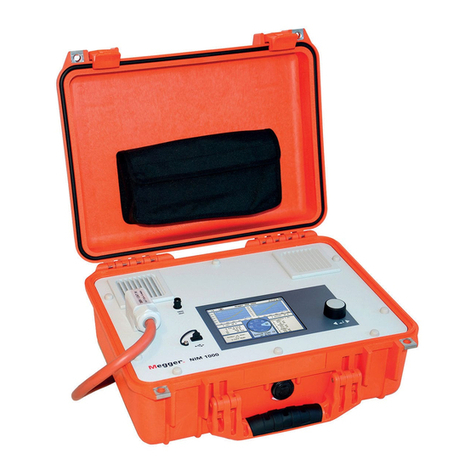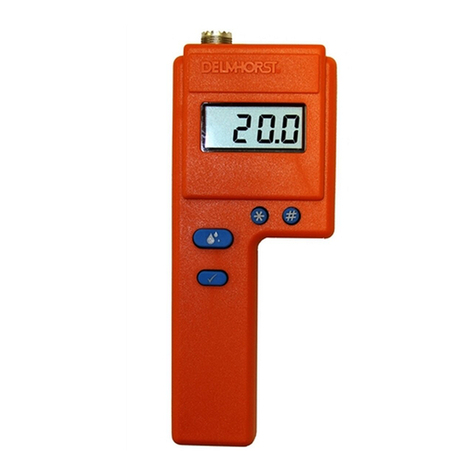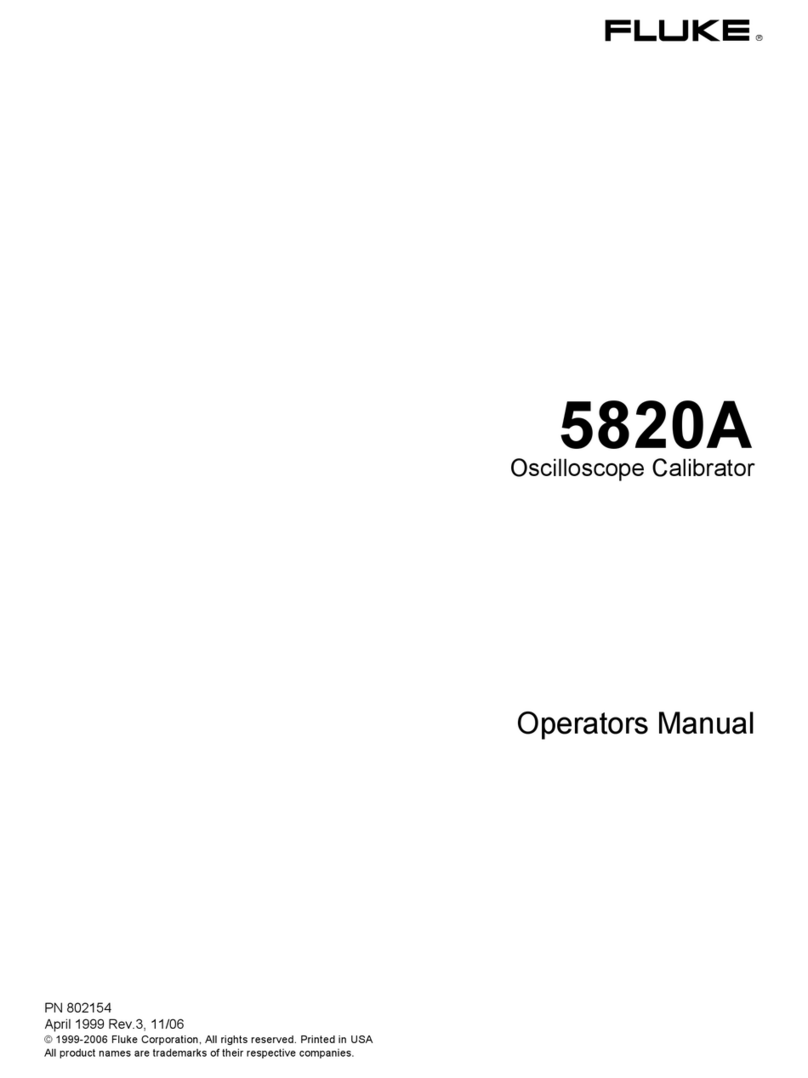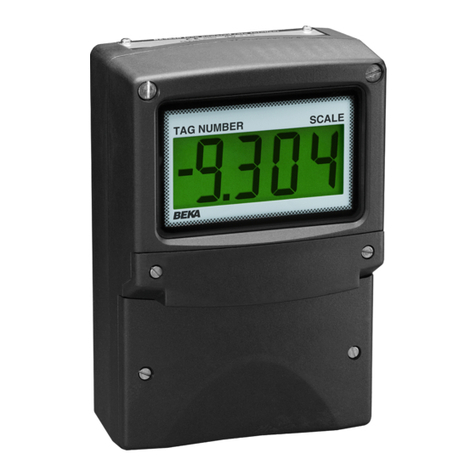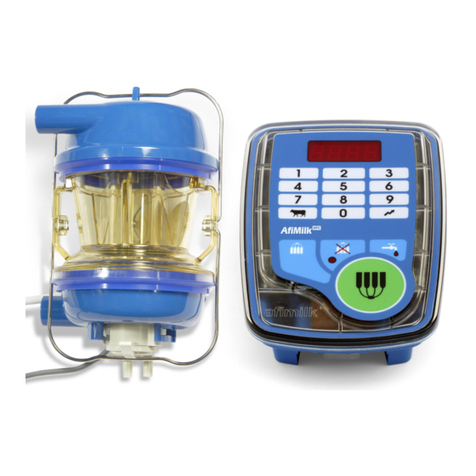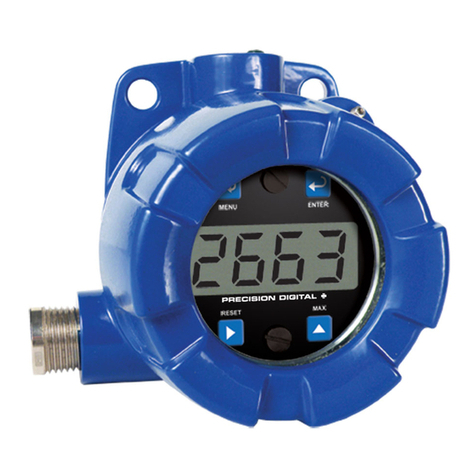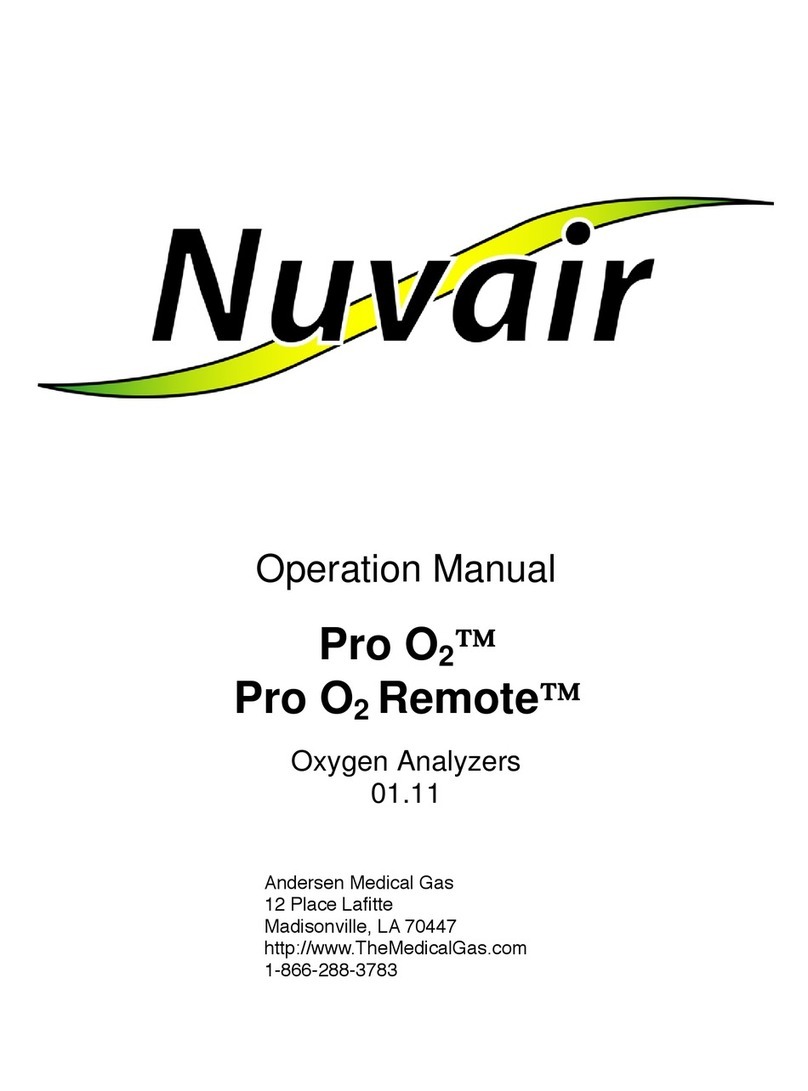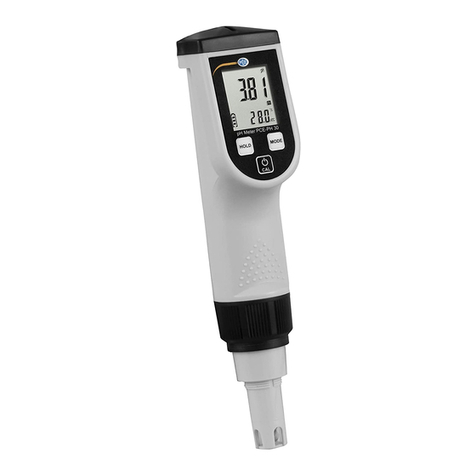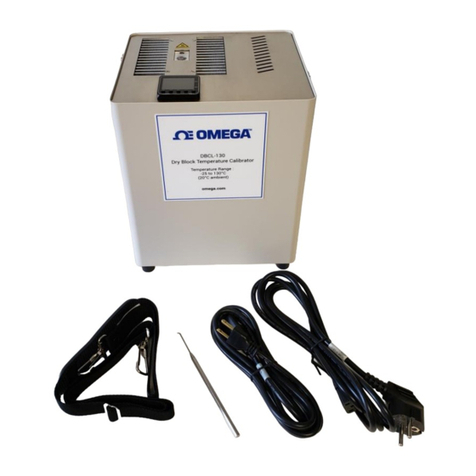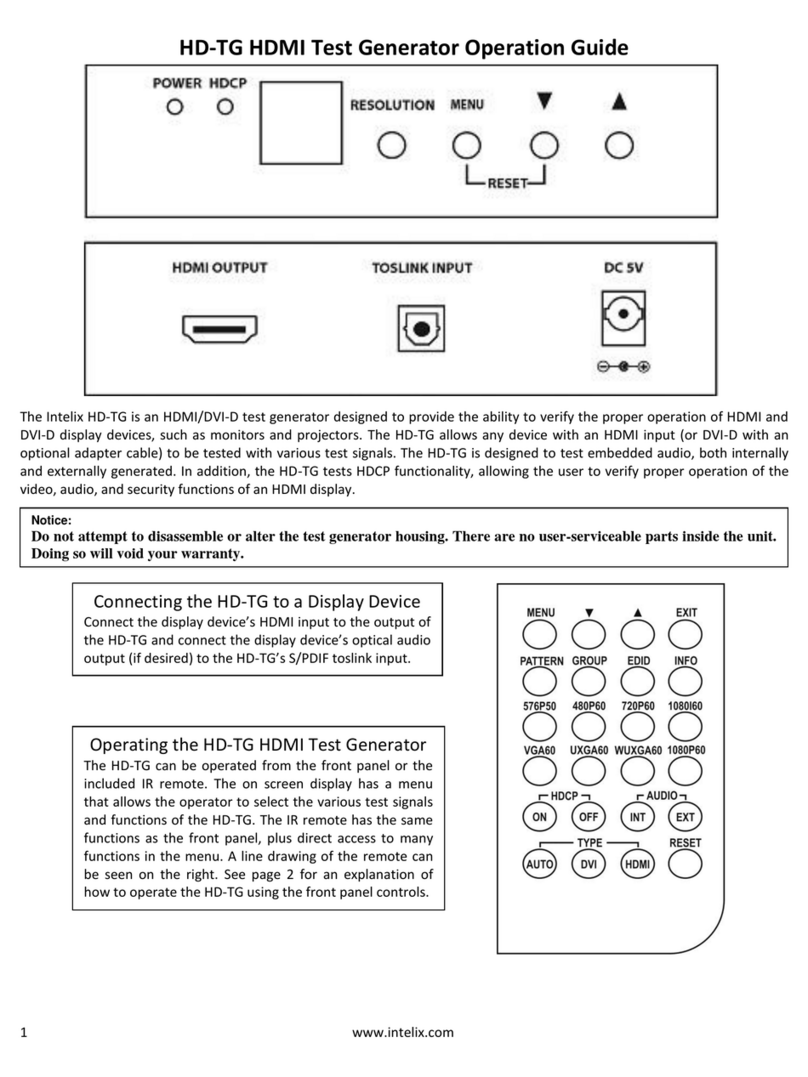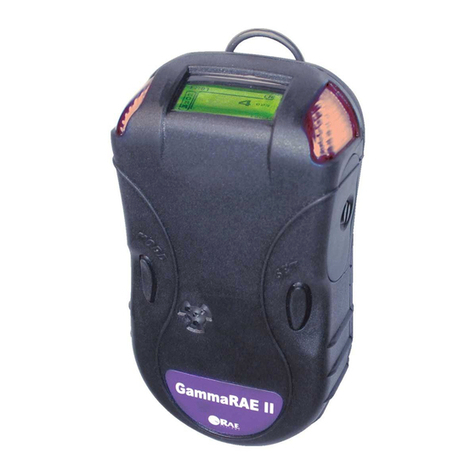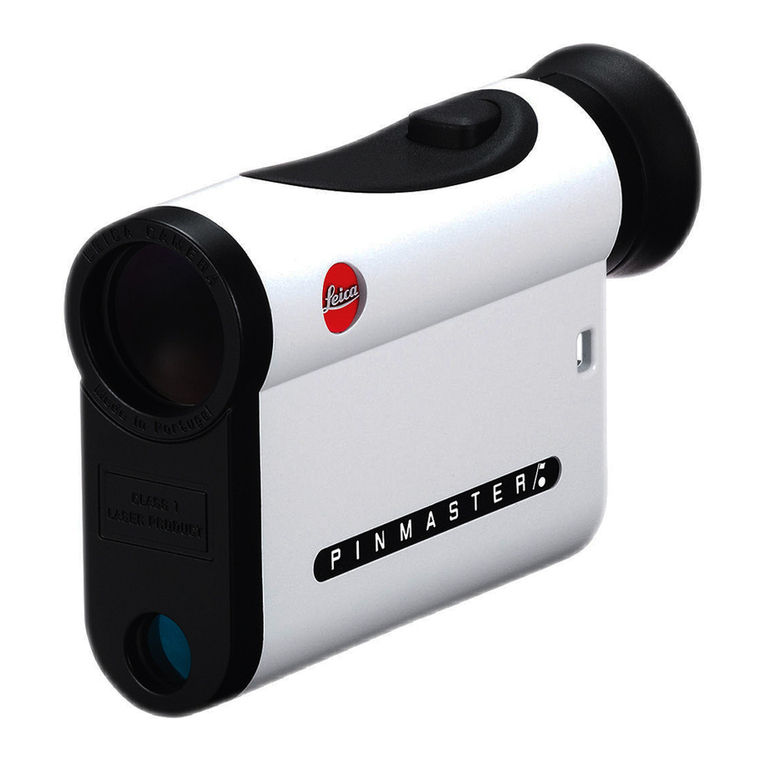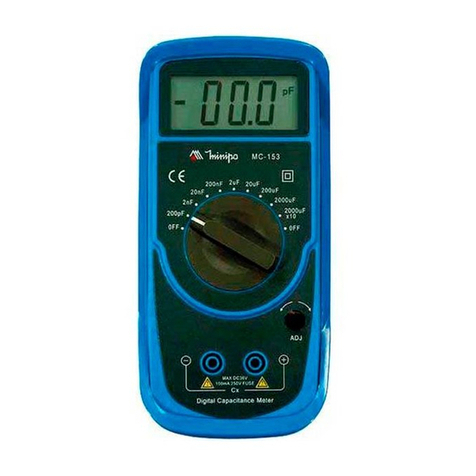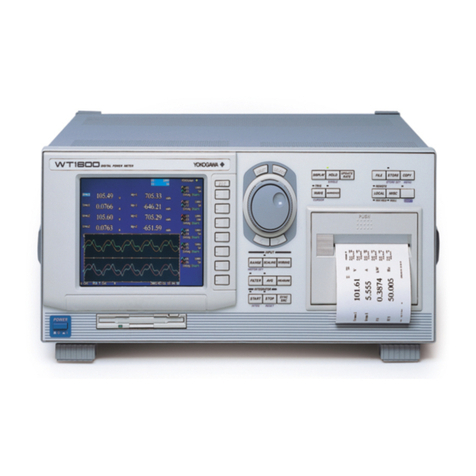Projekt Elektronik FM 302 User manual

AM BORSIGTURM 54
13507 BERLIN
TEL. 030 / 43 03 22 40
MESS - UND REGELUNGSTECHNIK GMBH FAX 030 / 43 03 22 43
Copyright P ojekt Elekt onik GmbH 26.02.2018
P ojekt Elekt onik
Operating Manual
Made in Germany

P ojekt Elekt onik
MESS - UND REGELUNGSTECHNIK GMBH Page 2
1. Warning
Observe personal protection rules!
Please read this Operating Manual carefully!
When measuring magnetic fields, consider and observe the
regulations concerning potential dangers caused by DC and AC
magnetic fields.
The direct influence of magnetic fields (for limits see DIN VDE 0848)
may be harmful to one's health.
The operation of cardiac pacemakers may be affected dangerous!
Examples for sources of potentially hazardous magnetic fields:
•ultrasonic sources
•induction heaters and furnaces
•magnetic resonance tomographs
•medical magnetic fields
More information can be obtained in the following documentation:
•Electromagnetic Compatibility (Elektromagnetische Verträglichkeit),
VDE, Vol. 1 to 4
•DIN VDE 0848

P ojekt Elekt onik
MESS - UND REGELUNGSTECHNIK GMBH Page 3
2. Technical Advice
Please read this Operating Manual carefully!
2.1 Transverse Probe
The transverse probe has a blue protective cap which have to be unscrewed
before measurement.
Utmost care and attention are needed if magnets have to be measured that
are not mechanically fixed. Clashing poles can destroy the Hall element!
As the Hall element (ceramic) is very sensitive to pressure or shock,
mechanical stress must be avoided (risk of breakage)!
2.2 Transverse Probe Brass
When measuring fields of B > 20 mT and f > 10 kHz, the probe brass
should not be operated for more than 1 min in order to prevent excessive
heating of the brass tube with the Hall element inside!
Attention should be paid to the fact that at the probe a connection exist
between GND, cable shield, plug housing and brass tube. Possibly an
isolated installation of the probe and/or plug would be necessary to prevent
an unintended connection between measuring ground and protective earth.
2.3 Transverse Probe Hot
The transverse probe has a protective cap which have to be drawn off
before measurement.
Only the probe, the handle and the cable are temperature-resistant. The
probe connector with the electronic may only be operated up to +50 °C.

2. Technical Advice
P ojekt Elekt onik
MESS - UND REGELUNGSTECHNIK GMBH Page 4
2.4 Transverse Probe Flex
The transverse probe has a protective cap which have to be drawn off
before measurement.
Only the probe itself is temperature-resistant. The handle, the cable and the
probe connector with the electronic may only be operated up to +50 °C.
No pressure shall be applied to the hall element (ceramic) because it is very
pressure sensitive (risk of breaking)!
2.5 Transverse Probe Wire
The wire probes are very sensitive. The wires of the probe may not be bend
at the element and may not be pulled.
Only the probe itself is temperature-resistant. The handle, the cable and the
probe connector with the electronic may only be operated up to +50 °C.
No pressure shall be applied to the hall element (ceramic) because it is very
pressure sensitive (risk of breaking)!
2.6 Axial Probe UAP
To be able to gain best stability in the 2 µT range the probe should be
switched on for at least 30 minutes.
The axis of the compensation potentiometer should not be exposed to
bending forces to prevent the axis and the potentiometer from damage.
2.7 AS-Probe Adapter
Attention should be paid that there is a connection between GND and cable
shield as well as the connector housing in the adapter cable. At brass
probes this is also connected to GND. Possibly an isolated installation of the
probe is necessary to prevent an unintended connection between measuring
GND and protective earth.

2. Technical Advice
P ojekt Elekt onik
MESS - UND REGELUNGSTECHNIK GMBH Page 5
2.8 AS-Adapter 3
One should be aware, that the probes and all outputs have a common
ground. Especially when using the brass version of AS-probes (AS-NTM,
AS-LTM) an isolation between probe and other parts of the measurement
setup can be necessary. It should be noted that the three adapter cables (X,
Y, Z) and the probes provide a connection between the GND and the cable
shield as well as the connector housing. Possibly an isolated installation of
the probe is necessary to prevent an unintended connection between
measuring GND and protective earth.
2.9 ESD
Electrostatic discharges (> 0.5 kV) to the sensor can damage it. Structural
safety measures would affect measurement accuracy due to loss of
sensitivity.
2.10 Minimum Operation Conditions (EMC)
Measurement results may vary up to 2 % in the presence of strong HF fields
(> 3 V/m).
2.11 Ground Connection / Earthing
It should be observed, that in the probe a connection between GND, plug
shield, plug case and cable shield is made. At bass probes, this is also
connected to GND. Possibly an isolated installation of the probe is
necessary to prevent an unintended connection between measuring GND
and protective earth.

P ojekt Elekt onik
MESS - UND REGELUNGSTECHNIK GMBH Page 6
3. Table of Contents
1.
Warning..............................................................................................................2
2.
Technical Advice...............................................................................................3
2.1
Transverse Probe .......................................................................................3
2.2
Transverse Probe Brass .............................................................................3
2.3
Transverse Probe Hot.................................................................................3
2.4
Transverse Probe Flex ...............................................................................4
2.5
Transverse Probe Wire...............................................................................4
2.6
Axial Probe UAP .........................................................................................4
2.7
AS-Probe Adapter.......................................................................................4
2.8
AS-Adapter 3 ..............................................................................................5
2.9
ESD ............................................................................................................5
2.10
Minimum Operation Conditions (EMC) .......................................................5
2.11
Ground Connection / Earthing ....................................................................5
3.
Table of Contents..............................................................................................6
4.
List of Figures .................................................................................................11
5.
Description ......................................................................................................13
5.1
Purpose of a Magnetic Field Meter ...........................................................13
5.2
General Description of Operation .............................................................13
5.2.1
Teslameter FM 302 .......................................................................13
5.2.2
AS-Active-Probe............................................................................15
5.2.2.1
Probe Extension Cord .....................................................17
5.2.3
AS-Probe Adapter .........................................................................17
5.2.4
AS-Adapter 3.................................................................................18
5.3
Items Supplied ..........................................................................................19
6.
Operation .........................................................................................................20
6.1
Introduction...............................................................................................20
6.2
Safety Notes .............................................................................................20
6.3
Teslameter FM 302...................................................................................21
6.3.1
Controls and Connectors...............................................................21
6.3.1.1
Housing ...........................................................................22
6.3.1.2
Handle.............................................................................22
6.3.1.3
top hat rail adapter (optional)...........................................22
6.3.1.4
Power Switch...................................................................22
6.3.1.5
Keypad ............................................................................22
6.3.1.6
Display.............................................................................23
6.3.1.7
Key “zero” – Offset Compensation ..................................25
6.3.1.8
Key “DC AC” – Measuring Mode .....................................27
6.3.1.9
Key “gain” – Measuring Range........................................27

3. Table of Contents
P ojekt Elekt onik
MESS - UND REGELUNGSTECHNIK GMBH Page 7
6.3.1.10
Key “unit” – Unit.............................................................. 28
6.3.1.11
Key “rel abs” – Relative Measurement............................ 28
6.3.1.12
Key “min max” – Minimal Measurement, Maximal
Measurement.................................................................. 29
6.3.1.13
Key “time” – Measuring Time.......................................... 29
6.3.1.14
Key “filter” – Filter ........................................................... 30
6.3.1.15
Acoustic Feedback ......................................................... 31
6.3.1.16
Analog Output................................................................. 31
6.3.1.17
Probe Connector............................................................. 32
6.3.1.18
USB Interface ................................................................. 32
6.3.1.19
Power Connector............................................................ 32
6.3.1.20
Battery Compartment...................................................... 32
6.3.2
Usage of The Teslameter FM 302 ................................................ 33
6.3.2.1
Time Response of Display and Analog Output ............... 34
6.3.2.2
Power Supply.................................................................. 35
6.3.2.3
Battery / Accumulator Operation..................................... 35
6.3.2.4
Power Adapter Operation ............................................... 35
6.3.2.5
USB Operation................................................................ 36
6.3.2.6
Display of Units with older AS-Active-Probe ................... 37
6.3.3
USB Interface ............................................................................... 38
6.3.3.1
General........................................................................... 38
6.3.3.2
Driver Installation Windows............................................. 38
6.3.3.3
Driver Installation Linux .................................................. 38
6.3.3.4
Configuration of the Virtual Serial Port............................ 39
6.3.3.5
General about Commands.............................................. 39
6.3.3.6
Command “absolute” ...................................................... 40
6.3.3.7
Command “coupling” ...................................................... 40
6.3.3.8
Command “default” ......................................................... 40
6.3.3.9
Command “digits” ........................................................... 41
6.3.3.10
Command “filter” ............................................................. 41
6.3.3.11
Command “fmstatus” or “status” ..................................... 41
6.3.3.12
Command “gain”............................................................. 42
6.3.3.13
Command “inttime” or “time” ........................................... 43
6.3.3.14
Command “keys” ............................................................ 43
6.3.3.15
Command “logging” ........................................................ 44
6.3.3.16
Command “maximum” .................................................... 44
6.3.3.17
Command “minimum” ..................................................... 45
6.3.3.18
Command “range”........................................................... 45
6.3.3.19
Command “relative” ........................................................ 45
6.3.3.20
Command “serial” ........................................................... 46
6.3.3.21
Command “sound” .......................................................... 47
6.3.3.22
Command “unit”.............................................................. 47
6.3.3.23
Command “version” ........................................................ 48
6.3.3.24
Command “zero”............................................................. 48

3. Table of Contents
P ojekt Elekt onik
MESS - UND REGELUNGSTECHNIK GMBH Page 8
6.3.4
Control Software FM 302 Control ..................................................49
6.3.4.1
General Description.........................................................49
6.3.4.2
Installation .......................................................................50
6.3.4.3
Connection to Teslameter FM 302 ..................................50
6.3.4.4
Display and Setting of parameters ..................................51
6.3.4.5
Oscilloscope Display .......................................................52
6.3.4.6
Logging of Measured Values...........................................53
6.3.4.7
Limit Comparator.............................................................56
6.3.4.8
Restore Factory Settings .................................................58
6.3.4.9
Uninstall...........................................................................58
6.3.4.10
Source Code ...................................................................58
6.4
AS-Active-Probe .......................................................................................59
6.4.1
Polarity ..........................................................................................59
6.4.1.1
Transverse Probe............................................................59
6.4.1.2
Axial Probe......................................................................60
6.4.2
Measuring Arrangement ................................................................61
6.4.3
Precision and Repeatability...........................................................62
6.4.4
Winding up of Cables ....................................................................62
6.4.5
Transverse Probe AS-NTP 0,6......................................................63
6.4.6
Transverse Probe Brass AS-NTM, AS-NTM-2, AS-LTM ...............63
6.4.7
Transverse Probe Hot AS-NTP-Hot-05 .........................................63
6.4.8
Transverse Probe Flex AS-NTP-Flex, AS-NTP-Flex 0,6 ...............64
6.4.9
Transverse Probe Wire AS-NCu-Wire...........................................64
6.4.10
Axial Probe AS-HAP, AS-NAP, AS-LAP........................................65
6.4.11
Axial Probe AS-UAP GEO-X, AS-UAP Lot ....................................65
6.4.12
Usage of the AS-Active-Probes.....................................................67
6.4.12.1
Usage with the Teslameter FM 302.................................67
6.4.12.2
Usage as Autonomous Transducer .................................67
6.4.12.3
Usage with the AS-Probe Adapter...................................69
6.4.12.4
Usage with the AS-Adapter 3 ..........................................69
6.4.13
Zero Chamber (optional) ...............................................................69
6.4.14
Linearity Curves (optional).............................................................69
6.5
AS-Probe Adapter.....................................................................................71
6.5.1
Controls and Connectors...............................................................71
6.5.2
Structure........................................................................................72
6.5.2.1
Supply Voltage Inputs......................................................73
6.5.2.2
Power LED ......................................................................73
6.5.2.3
Probe Supply...................................................................73
6.5.2.4
Probe Signal Input...........................................................73
6.5.2.5
Measurement Signal Output............................................73
6.5.2.6
Gain Switch .....................................................................74
6.5.3
Adapter Cable ...............................................................................74
6.5.4
Usage of the AS-probe adapter.....................................................75
6.6
AS-Adapter 3 ............................................................................................76

3. Table of Contents
P ojekt Elekt onik
MESS - UND REGELUNGSTECHNIK GMBH Page 9
6.6.1
Controls and Connectors .............................................................. 76
6.6.2
Overview of Controls and Connections......................................... 76
6.6.2.1
Supply Voltage Inputs..................................................... 78
6.6.2.2
Power LED...................................................................... 78
6.6.2.3
Probe Supply .................................................................. 78
6.6.2.4
Probe Signal Input .......................................................... 78
6.6.2.5
Measurement Signal Output ........................................... 78
6.6.2.6
Gain Switch..................................................................... 79
6.6.3
Adapter Cable............................................................................... 79
6.6.4
Usage of the AS-Adapter 3........................................................... 82
7.
Technical Specifications................................................................................ 85
7.1
Teslameter FM 302 (without AS-Active-Probe):....................................... 85
7.2
AS-Active-Probes..................................................................................... 88
7.2.1
Sensitivity Classes – Overview ..................................................... 90
7.2.2
AS-active-probes – Overview Normal........................................... 93
7.2.3
AS-active-probes – Overview Earth Magnetic Field...................... 94
7.2.4
AS-active-probes – Overview High Field ...................................... 94
7.2.5
AS-active-probes – Overview Low Field ....................................... 95
7.2.6
AS-active-probes – Overview Further Data .................................. 96
7.2.7
Axial Probe 12 T (AS-HAP)........................................................... 97
7.2.8
Transverse Probe 2000 mT (AS-NTP 0,6).................................... 98
7.2.9
Transverse Probe Brass 2000 mT (AS-NTM) ............................... 99
7.2.10
Transverse Probe Brass with Very High Precision 2000 mT (AS-
NTM-2)........................................................................................ 100
7.2.11
Axial Probe 2000 mT (AS-NAP).................................................. 101
7.2.12
Transverse Probe Hot with Improved Temperature Characteristics
2000 mT (AS-NTP-Hot-05) ......................................................... 102
7.2.13
Transverse Probe Flex 2000 mT (AS-NTP-Flex) ........................ 103
7.2.14
Transverse Probe Flex 2000 mT (AS-NTP-Flex 0,6) )............... 104
7.2.15
Transverse Probe Wire 2000 mT (AS-NCu-Wire)....................... 105
7.2.16
Transverse Probe Brass 200 mT (AS-LTM)................................ 106
7.2.17
Axial Probe 200 mT (AS-LAP) .................................................... 107
7.2.18
GEO-X Axial Probe 200 µT (AS-UAP GEO-X)............................ 108
7.2.19
Lot Axial Probe 200 µT (AS-UAP Lot)......................................... 109
7.3
AS-Probe Adapter.................................................................................. 110
7.4
AS-Adapter 3.......................................................................................... 111
8.
Maintenance.................................................................................................. 114
8.1
Visual Inspection.................................................................................... 114
8.2
Checking Battery.................................................................................... 114
8.3
Maintaining Accumulators ...................................................................... 114
8.4
Cleaning................................................................................................. 115

3. Table of Contents
P ojekt Elekt onik
MESS - UND REGELUNGSTECHNIK GMBH Page 10
8.5
Warranty Provisions................................................................................115
9.
Customer Service..........................................................................................116
9.1
Calibration...............................................................................................116
9.2
Repairs ...................................................................................................116
9.3
Follow-up Orders ....................................................................................116
9.4
Disposal..................................................................................................116
10.
EU Declaration of Conformity ......................................................................117
11.
Index...............................................................................................................118
Gebrauchseinweisung FM 302 0203-116.docx

P ojekt Elekt onik
MESS - UND REGELUNGSTECHNIK GMBH Page 11
4. List of Figures
Figure 1 Example of an order of FM 302 with three probes and options ................19
Figure 2 Controls and connectors FM 302..............................................................21
Figure 3 Keypad of Teslameter FM 302 .................................................................22
Figure 4 Display of Teslameter FM 302..................................................................23
Figure 5 Display of serial number and firmware version .........................................23
Figure 6 Display of Teslameter FM 302..................................................................23
Figure 7 Display without probe ...............................................................................24
Figure 8 Display while range overflow ....................................................................24
Figure 9 Display battery state .................................................................................24
Figure 10 Display supply by power adapter or USB ...............................................25
Figure 11 Display while offset compensation process ............................................25
Figure 12 Display error message offset out of range..............................................26
Figure 13 Display reset offset compensation ..........................................................26
Figure 14 Display measuring mode ........................................................................27
Figure 15 Display in relative measurement.............................................................28
Figure 16 Display in minimal measurement............................................................29
Figure 17 Display in maximal measurement...........................................................29
Figure 18 Display measuring timeout .....................................................................30
Figure 19 Display filter length .................................................................................30
Figure 20 Usage of Teslameter FM 302 .................................................................33
Figure 21 Time response........................................................................................34
Figure 22 Display with not representable unit.........................................................37
Figure 23 Control software FM 302 Control............................................................49
Figure 24 Value display of the control software ......................................................51
Figure 25 Control of keypad lock and acoustic feedback........................................51
Figure 26 Control of the FM 302 settings................................................................52
Figure 27 Oscilloscope-like display.........................................................................53
Figure 28 Setting logging parameter.......................................................................53
Figure 29 Log file example......................................................................................54
Figure 30 Single value logging................................................................................54
Figure 31 Continuous value logging .......................................................................55
Figure 32 Log preview ............................................................................................56
Figure 33 Limit comparator.....................................................................................56
Figure 34 Oscilloscope display with limits of limit comparator ................................57
Figure 35 Reset to the factory settings ...................................................................58
Figure 36 Measurements using a transverse probe................................................59
Figure 37 Trigonometric of the measuring arrangement.........................................59
Figure 38 Measurements using an axial probe.......................................................60
Figure 39 Trigonometric function of the axial probe................................................60
Figure 40 Measuring arrangement bar magnet.......................................................61
Figure 41 Measuring arrangement cylindrical coil...................................................62
Figure 42 Transverse probe 0,6..............................................................................63
Figure 43 Transverse probe brass..........................................................................63
Figure 44 Transverse probe Hot.............................................................................63
Figure 45 Transverse probe Flex............................................................................64
Figure 46 Transverse probe Flex 0,6......................................................................64

4. List of Figures
P ojekt Elekt onik
MESS - UND REGELUNGSTECHNIK GMBH Page 12
Figure 47 Transverse probe Wire........................................................................... 64
Figure 48 Axial probe ............................................................................................. 65
Figure 49 Axial probe AS-UAP GEO-X................................................................... 65
Figure 50 Axial probe AS-UAP Lot ......................................................................... 65
Figure 51 Controls connector AS-UAP ................................................................... 66
Figure 52 Usage of AS-active-probe with FM 302.................................................. 67
Figure 53 Usage AS-probe at ±3 V......................................................................... 68
Figure 54 Pin configuration AS-probe at ±3 V ........................................................ 68
Figure 55 Structure AS-active-probe ...................................................................... 69
Figure 56 Zero Chamber ........................................................................................ 69
Figure 57 Typical linearity curves ........................................................................... 70
Figure 58 Controls and connections AS-probe adapter.......................................... 71
Figure 59 Structure AS-probe adapter.................................................................... 72
Figure 60 Adapter cable ......................................................................................... 74
Figure 61 Connection AS-probe adapter................................................................ 75
Figure 62 Controls and connectors AS-Adapter 3 .................................................. 76
Figure 63 Structure AS-Adapter 3 .......................................................................... 78
Figure 64 Adapter cable „X, Y, Z”........................................................................... 81
Figure 65 Connection AS-Adapter 3 with 1-axis AS-active probes......................... 83
Figure 66 Connection AS-Adapter 3 with 3-axis AS-active probe .......................... 84
Figure 67 AS-NTP 0,6 transverse probe ................................................................ 88
Figure 68 AS-NTM, AS-LTM and AS-NTM-2 transverse probe brass .................... 88
Figure 70 AS-NTP-Hot-05 transverse probe .......................................................... 88
Figure 71 AS-NTP-Flex transverse probe .............................................................. 88
Figure 72 AS-NTP-Flex 0,6 transverse probe ........................................................ 88
Figure 73 AS-NCu-Wire transverse probe Wire ..................................................... 88
Figure 69 AS-NAP, AS-LAP and AS-HAP axial probe............................................ 89
Figure 74 AS-UAP GEO-X axial probe ................................................................... 89
Figure 75 AS-UAP Lot axial probe ......................................................................... 89
Figure 76 Size axial probe 12 T (AS-HAP)............................................................. 97
Figure 77 Size transverse probe 2000 mT (AS-NTP 0,6)....................................... 98
Figure 78 Size transverse probe brass 2000 mT (AS-NTM)................................... 99
Figure 79 Size transverse probe brass 2000 mT (AS-NTM-2) ............................. 100
Figure 80 Size axial probe 2000 mT (AS-NAP) .................................................... 101
Figure 81 Size transverse probe Hot 2000 mT (AS-NTP-Hot-05) ........................ 102
Figure 82 Size transverse probe Flex 2000 mT (AS-NTP-Flex) ........................... 103
Figure 83 Size transverse probe Flex 2000 mT (AS-NTP-Flex 0,6) ..................... 104
Figure 84 Size transverse probe Wire 2000 mT (AS-NCu-Wire) .......................... 105
Figure 85 Size transverse probe brass 200 mT (AS-LTM) ................................... 106
Figure 86 Size axial probe 200 mT (AS-LAP)....................................................... 107
Figure 87 Size GEO-X axial probe 200 µT (AS-UAP GEO-X).............................. 108
Figure 88 Size Lot axial probe 200 µT (AS-UAP Lot) ........................................... 109
Figure 89 AS-probe adapter ................................................................................. 110
Figure 90 AS-Adapter 3........................................................................................ 112

P ojekt Elekt onik
MESS - UND REGELUNGSTECHNIK GMBH Page 13
5. Description
5.1 Purpose of a Magnetic Field Meter
The Teslameter FM 302, the AS-active-probes, the AS-probe adapter and
the AS-Adapter 3 form a handy measuring system which allows to measure
magnetic fields in a wide scope of application. This includes alternating
fields of electromagnets as well as constant magnetic fields of permanent
magnets.
For normal use of the instrument, please refer to section 6 Operation.
5.2 General Description of Operation
The measuring system consists of the Teslameter FM 302 and/or AS-probe
adapter and/or AS-Adapter 3 at least one pluggable AS-active-probe which
contains the sensor.
By the use of pluggable probes, the system may be fast and easily adopted
to different measuring tasks. Depending on the probe, fields from a few
nano-Tesla up to 12 Tesla can be measured. After plugging in the desired
probe one can start to measure immediately without adjustment of zero and
scale since the AS-active-probes have an active electronic which matches
the properties of the sensor to the measuring range of the probe.
There are different probes available which fulfill the requirements
-to the geometry of the cavity to be measured,
-to the strength of the magnetic flux,
-to the treatment,
-to the size of the active sensor area,
-or to the operating temperature.
The selection of probes is regularly extended. This is done especially by
requests of customers.
5.2.1 Teslameter FM 302
The Teslameter FM 302 has a 4 ½ digit display and three measuring
ranges. The sensitivity of the ranges depends on the used probe and differ
in factor 10 and factor 100. The polarity is displayed by the sign. The
displayed unit can be switched between Tesla, Gauss, Oersted and A/m.
The Teslameter FM 302 can used to measure steady as well as alternating
magnetic fields up to 100 kHz (depending on the probe type). For AC-fields
alternatively the mean value (DC) or the effective value (true RMS) can be
displayed (see section 6.3.2 Usage of The Teslameter FM 302).

5. Description
P ojekt Elekt onik
MESS - UND REGELUNGSTECHNIK GMBH Page 14
Another feature of the Teslameter FM 302 is the calibrated analog output,
which is useful for display purposes (oscilloscope, plotter), data logging
(computer) and field control. Here the measured signal in DC or AC coupling
can be selected.
The operation of the Teslameter FM 302 is done via the keypad with 8 keys
which allow to set the functions of the device. For example the measuring
time can be adjusted to meet the requirements of the respective measuring
task, depending if a rather fast capturing of measured values or low noise
measured values are more important. For further filtering a digital filter can
be activated which works as a moving average filter on the measured
values.
In addition to absolute measurement the Teslameter FM 302 offers a
function to relative measurement and for measuring the minimal and
maximal value.
Moreover the Teslameter FM 302 features a USB interface which allows to
control the device and read out the measured values. There are even more
control options available. Also the device can be powered via the USB
connection. At the computer side the Teslameter FM 302 appears as a
virtual serial port so it is easy to integrate the device into existing systems.
The Teslameter FM 302 with its AS-active-probes is not disturbed in its
function by stronger magnetic fields. The device works reliable even at a DC
field of 350 mT. Neither the actual measurement nor the communication with
the computer is interfered. It has just to be considered the occurring action
of force of the device. The main reasons are the battery and the probe
connector.
The Teslameter FM 302 is delivered with a control software. The software
allows to control all settings of the Teslameter via the PC. Thereby the
software offers the complete range of functions which are possible with the
commands via the USB interface.
Besides the simple display of the measured value the software offers an
oscilloscope like display of the last 100 measured values. The time axis
depends on the selected measuring time. The scale of the amplitude axis is
given by the connected probe and the selected sensitivity of the FM 302.

5. Description
P ojekt Elekt onik
MESS - UND REGELUNGSTECHNIK GMBH Page 15
Additionally an amplification to one-tenth of the measurement range can be
activated. The created chart can be saved in different graphic formats.
The control software do not just allow to display the measured values of the
FM 302 but also allows to save them into a log file. For this two different
modes are offered. In the mode “single value logging” single measured
values can be saved with a key press (mouse or keyboard). This mode is
suitable for manual controlled measurements where a number of single
values has to be measured. Otherwise in the mode “continuous value
logging” the measured value are automatically stored continuously into the
log. This mode is suitable to record traces over longer periods of time.
For storing there can be chosen from two different formats. The log can be
saved in classic csv format (comma separated values) where the single data
blocks are separated by a comma and the period is used as decimal
separator. Alternatively the semicolon may be used for separating the data
blocks which makes available the comma as decimal separator. This
settings simplifies the import into software with German localization.
As another function the software offers a limit comparator. An upper and a
lower limit may be entered. The software shows if the current measured
value is below the lower limit, between both limits or above the upper limit.
This function allows e.g. the quick incoming inspection of permanent
magnets.
The polarity can be ignored while checking the compliance with the given
limits. Additionally the set limits can be displayed in the oscilloscope-like
display.
5.2.2 AS-Active-Probe
The AS-active-probes are active probes to measure the magnetic induction.
In contrast to most other available probes, the AS-probes contain an active
electronic so that a calibrated analog signal is available at the plug.
The transverse probe made of glass fiber fabric (AS-NTP 0,6) with their
slight thickness make it possible to measure in narrow air gaps and difficult-
to-reach locations. For transportation the probe is protected by a cap.
Further-more the probe carrier is temperature resistant up to 100 °C.

5. Description
P ojekt Elekt onik
MESS - UND REGELUNGSTECHNIK GMBH Page 16
For rough operating conditions the transverse probe is provided in a design
with brass protective tube (AS-LTM, AS-NTM). However they are thicker
than the AS-NTP 0,6.
The transverse probes AS-NTP-Flex and AS-NTP-Flex 0,6 are made with a
strip of very thin, extreme flexible and bendable material. They are qualified
to measure remarkable hard to reach locations and smallest air gaps.
Furthermore the probe carrier is temperature resistant up to 100 °C at the
AS-NTP-Flex and even up to 150 °C at the AS-NTP-Flex 0,6.
The probe AS-NCu-Wire is an extra thin sensor connected with very light
wires. Thus the probe is suited to measure at closed quarters and to mount
into complex measurement setups.
At very high demands to accuracy and temperature stability the probe
AS-NTM-2 may be used. Linearity error and temperature drift have been
highly reduced compared to the other probes.
The transverse high-temperature probe AS-NTP-Hot-05 is designed to
measure even at high temperatures up to 150 °C and at low temperatures
down to –40 °C. The probe itself and the probe cable are constructed to
permanently endure those temperatures.
The also available axial probes (AS-LAP, AS-NAP, AS-HAP) have a small
diameter and thus are suitable to measure fields in small coils.
With the axial AS-UAP probes particularly small fields can be measured with
a resolution down to one nano Tesla. Furthermore it has the facility to
compensate ±70 µT which for example provides the possibility to
compensate the earth magnetic field. So only differences are measured
which can be done with higher resolution.
The AS-UAP probe is available in two types. The AS-UAP GEO-X probe is
suitable for general measuring tasks while the AS-UAP Lot probe with their
special plummet housing with weighted tip is mainly suitable for measuring
the vertical component of the earth magnetic field.
All AS-active-probes can be used without the Teslameter as transducer at
an PLC, see section 6.4.12.2 Usage as Autonomous Transducer.

5. Description
P ojekt Elekt onik
MESS - UND REGELUNGSTECHNIK GMBH Page 17
5.2.2.1 Probe Extension Cord
Based on the fact, that the AS-active-probes are active probes, whose
electronic outputs a calibrated voltage signal related to the measured flux
density, a probe extension cord can be inserted between AS-active-probe
and Teslameter FM 302, AS-Adapter 3 or PLC without negative influence on
the measuring signal. So even wider distances between measured object
and measuring device can be bridged.
Appropriated extension cords are optional available in different lengths.
5.2.3 AS-Probe Adapter
The AS-probe adapter is designed to autonomously operate our AS-
active-probes without Teslameter.
As a result of the wide supply voltage range of 9 V
DC
to 36 V
DC
the AS-probe
adapter may be used universal in different system configurations.
Furthermore the AS-probe adapter galvanically isolates the power supply
from the probe supply and the measuring electronic.
The AS-probe adapter provides high stable ±3 V necessary to supply the
AS-active-probes. To ease the connection of the AS-active-probe to existing
analog inputs with ±10 V input range, the AS-probe adapter contains an
integrated amplifier. This amplifies the output signal of the AS-active-probes
from ±2 V to ±10 V. With a switch, an additionally 10times higher gain can
be chosen which allows to perform even sensitive measurements.
The analog output of the adapter is calibrated and thus can be used e.g. for
displaying magnetic pulses in the µs-range (oscilloscope), recording of
measurements and for field control. The bandwidth of the analog output
reaches from DC to a least 100 kHz. Therefore it is suitable for measuring
both constant magnetic fields and alternating magnetic fields.
Included in delivery is an adapter cable which allows the easy connection of
the 15-pole SubD connector of the AS-active-probes with the screw
terminals of the AS-probe adapter.

5. Description
P ojekt Elekt onik
MESS - UND REGELUNGSTECHNIK GMBH Page 18
5.2.4 AS-Adapter 3
The AS-Adapter 3 is used for the autonomous operation of 1-axis and 3-axis
AS active probes. The signals from all 3 probes are available simultaneously
and in parallel via the BNC connections or via the terminal contacts.
The AS-Adapter 3 supplies the AS active probes with ± 3 V in a highly stable
manner. The probe signals are amplified with x5 or x50, so that with ± 2 V or ±
0.2 V they can output ± 10 V for a PLC system and Provide oscilloscope.
The wide supply voltage range is 9 VDC to 36 VDC. The signals and supply of
the probes are galvanic isolated from the operating voltage.
The analog output of the AS-adapter 3 is calibrated and thus can be used
e.g. for displaying magnetic pulses in the µs-range (Oscilloscope), recording
of measurements and for field control. The bandwidth of the analog output
reaches from DC to a least 100 kHz. Therefore it is suitable for measuring
both constant magnetic fields and alternating magnetic fields. The actual
usable bandwidth depends on used AS-active probe.
After connecting the desired probe, the measurement can start without
adjusting zero and scale because all AS-active probes are calibrated. Hence
replacement probes can be used at any time.
All of our AS-active probes may be connected to the AS-Adapter 3. This
allows the fast adaptation to different measuring task by simply plugging in a
different probe. Depending on the type of AS-active probe fields from a few
nano Tesla up to 12 Tesla can be measured. Further information can be
found in the data sheet of the AS-active probes.
The AS-Adapter 3 has table feet’s and a DIN rail holder mount for cabinet
device mounting.

5. Description
P ojekt Elekt onik
MESS - UND REGELUNGSTECHNIK GMBH Page 19
5.3 Items Supplied
The delivered content depends on the concrete order. It may contained::
Teslameter FM
302
AS
-
Probe A
dapter
- case with replacement battery - 5 m adapter cable for probe connection
- factory calibration certificate - factory calibration certificate
- 1.8 m USB cord - 9 V plug-in power supply unit for
- CD with drivers and control software AS-probe adapter (optional)
- power adapter (optional)
- top hat rail adapter fixed to the device
AS
-
Adapter 3
(optional) - 3 pieces 5 m adapter cable for probe
connection
AS
-
active
-
probe
- factory calibration certificate
- factory calibration certificate - 9 V plug-in power supply unit for
- zero chamber (optional) AS-probe adapter (optional)
- linearity curve (optional)
- probe extension cord (optional)
operating manual
Figure 1 Example of an order of FM 302 with three probes and options

P ojekt Elekt onik
MESS - UND REGELUNGSTECHNIK GMBH Page 20
6. Operation
6.1 Introduction
This Operating Manual should be read carefully before measuring
instrument is operated for the first time.
Projekt Elektronik GmbH will not be responsible for damage to the
instrument caused by disregarding this Operating Manual. Neither will
responsibility be assumed for consequential damage resulting from
such mishandling of the instrument.
Also before initial operation, the content of the case should be checked for
completeness of the items supplied (see section 5.3 Items Supplied)!
6.2 Safety Notes
In order to ensure safe operation of the instrument, be sure to observe the
following recommendations:
•The magnetic field meter was tested after manufacture for compliance
with all applicable safety standards and regulations. To preserve this
condition and to ensure safe operation, the user should be sure to
observe all safety notes and cautions included in this Operating Manual.
•Before measurements, check your probe, probe cord, probe housing,
Teslameter housing, AS-Probe Adapter-housing, AS-Adapter 3-housing,
power adapter and power cord for damage.
•If you believe that the instrument cannot be operated safely any longer,
switch it OFF, mark it accordingly and keep it in a manner to prevent
unintentional use.
Safe operation will not be possible if the unit, the probe, any connecting
cable, the battery or the accumulator, power adapter or power cord show
visible damage, or if the unit fails to operate.
•This instrument must not be handled by children!
•Due attention should be given to the accident prevention rules issued by
authorized bodies, especially to any rules concerning electromagnetic
fields.
Table of contents
Other Projekt Elektronik Measuring Instrument manuals





